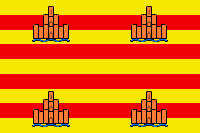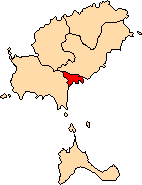Ibiza: Difference between revisions
No edit summary |
m External link to Ibiza google maps added |
||
| Line 103: | Line 103: | ||
*[http://www.amics-terra.org ''Amics de la Terra Eivissa'' (part of Friends of the Earth International)] |
*[http://www.amics-terra.org ''Amics de la Terra Eivissa'' (part of Friends of the Earth International)] |
||
*[http://www.ibiza-spotlight.com/ibizamagic/history_i.htm''The history of Ibiza and Formentera''] |
*[http://www.ibiza-spotlight.com/ibizamagic/history_i.htm''The history of Ibiza and Formentera''] |
||
*[http://www.ibizaa-z.com/index.php?option=com_wrapper&Itemid=226''Google Maps of Ibiza''] |
|||
{{Municipalities in the Balearic Islands}} |
{{Municipalities in the Balearic Islands}} |
||
Revision as of 07:14, 7 June 2007
- Ebusus redirects here. For the genus of grass skipper butterflies, see Ebusus (butterfly).
| UNESCO World Heritage Site | |
|---|---|
 | |
| Criteria | Mixed: ii, iii, iv, ix, x |
| Reference | 417 |
| Inscription | 1999 (23rd Session) |
Ibiza (Catalan: Eivissa) is one of the Balearic Islands located in the Mediterranean Sea (38°59′N 1°26′E / 38.98°N 1.43°E), belonging to Balearic Islands (Spain). With Formentera, it is one of the two Pine Islands. Major cities are Ibiza, Santa Eulària des Riu and Sant Antoni de Portmany.
The name Ibiza is derived from the Original Arabic word "Yabisah" " يابسة" meaning Land or Landward in English. Eivissa is the official Catalan name pronounced [əj'vi.sə]; but the name in Spanish is Ibiza (usually pronounced using the Castilian variation [iˈβ̞i.θa], often manifested by English speakers [ɪˈbi.t͡sa]).
The Island of Ibiza is most famously known for its summer parties, with thousands of people flooding in for the big summer club nights. Famous clubs include Space, Pacha, Privilege(ex Ku), Amnesia, Eden and Es Paradis. They are hosts to parties of international fame such as Cream, Manumission, etc. It is also home to the 'West End' party district of Sant Antoni, a rite of passage for many partygoers.
History

In 654 BC Phoenician settlers founded a port in the Balearic Islands, as Ibossim (from the Phoenician ibshim "island of pines"). It was later known to Romans as "Ebusus". The Greeks, who came to Ibiza during the time of the Phoenicians, were the first to call the two islands of Ibiza and Formentera the Pitiusas ("pine-covered islands"; a translation of the Phoenician name). With the decline of Phoenicia after the Assyrian invasions, Ibiza came under the control of Carthage, also a former Phoenician colony. The island produced dye, salt, fish sauce (garum), and wool.

A shrine with offerings to the goddess Tanit was established in the cave at Es Culleram, and the rest of the Balearic Islands entered Eivissa's commercial orbit after 400 BC. Ibiza was a major trading post along the Mediterranean routes. Iberia began establishing its own trading stations along the nearby Balearic island of Mallorca, from which large quantities of renowned Balearic slingers were hired as mercenaries who fought for Carthage.
During the Second Punic War, the island was assaulted by the two Scipio brothers 209 BC but remained loyal to Carthage. With Carthaginian military luck running out on the Iberian mainland, Ibiza was last used by the fleeing Carthaginian General Mago to gather supplies and men before sailing to Menorca and then to Liguria. Ibiza negotiated a favorable treaty with the Romans, which spared Ibiza from further destruction and allowed it to continue its Carthaginian-Punic institutions well into the Empire days, when it became an official Roman municipality. For this reason, Ibiza today offers excellent examples of late Carthaginian-Punic civilization. During the Roman Empire, the island became a quiet imperial outpost, removed from the important trading routes of the time.
After the fall of the Roman empire and a brief period of Vandal first and then Byzantine rule, the island was conquered by the Moors, as much of the Iberian peninsula. Under the Islamic rule, Ibiza became in close contact with the city of Dénia (the closest port in the nearby Iberian peninsula, located in the Land of Valencia) as the two areas were administered jointly by the same taifa. Moreover the tribes who lived in Ibiza and Denia during that time 1060 -1085 where Moorish tribes named Bno- Alaglab & Bano- Mujahed .
The island was put back in Christian hands by Catalan King James I of Aragon in 1235. Since then, the island has had its own self-government in several forms but in 1715 King Philip V of Spain abolished the local government's autonomy. The arrival of democracy in the late seventies led to the Statute of Autonomy of the Balearic Islands. Today the island is part of the Balearic Autonomous Community, along with Mallorca, Menorca and Formentera.
Climate
The climate of Ibiza is Mediterranean and has milder winters and slightly cooler summers than Mallorca. The winters are mild with temperatures around 15° Celsius (60° Fahrenheit) and some rain. The hot summer season lasts from June to September inclusive with temperatures regularly reaching 30°C (85°F), lots of sunshine and very little rain. Frost and snow are very rare.
Tourism

Ibiza is a very popular tourist destination, especially due to its legendary and at times riotous nightlife centered around two areas: Ibiza Town, the island's capital on the eastern shore and Sant Antoni to the West. Ibiza Town has become a popular destination for tourists. The most famous clubs include Privilege (the largest club in the world), Eden (the busiest nightclub in Sant Antoni), Es Paradís (noted for its water parties), Amnesia (known for foam parties), Space (an afterparty club), Pacha, and DC10. These clubs have become the centre of the worldwide electronic music movement. During the summer, world class DJs perform at the various clubs on weekly schedules, in between touring to other international destinations. Many of these DJs use Ibiza as an outlet for presenting new songs within the house and trance genres of electronic dance music. A typical schedule for clubbers going to Ibiza includes waking at noon, early evening naps, late night clubbing, and "disco sunrises". Due to Ibiza's notable tolerance toward misbehavior from young adult tourists, it has acquired the sobriquet "Gomorrah of the Med". It is also famous for Café del Mar, a long-standing bar where many tourists traditionally view the sunset made famous by José Padilla. Café Mambo is situated next door, and has become an increasingly popular venue for club pre-parties after sunset, boasting big names such as Roger Sanchez, David Morales, Frankie Knuckles, Pete Tong, Paul Oakenfold, Sasha, Erick Morillo and David Guetta.

The island is not just known for its party scenes, though, as large portions of the island are registered as U.N. World Heritage Sites, and thus devoid of the commercialization of the main cities, for example, "God's Finger" in the Benirràs Bay, or more traditional Ibicenco cultural sites. Because of its purported natural beauty, companies and artists alike frequently use the island for photographic and film shoots. A monument ("The Egg") erected in honour of Christopher Columbus can be found in Sant Antoni: Ibiza is one of several places purporting to be his birthplace.
However, any time other than summer, the whole island is empty of tourists and most clubs are not open. Tourists who plan to travel to the island prior to July or after September should expect a quiet time with plenty of rain. The island is still considered to be beautiful, but tourists coming for the night life may be disappointed.
Spectacular sites can be seen from all over the island and this includes the wonderous Es Vedrà which is the 3rd most magnetic point on earth, behind the North Pole and The Bermuda Triangle. [1]
Administration

Ibiza is administratively part of the autonomous community of the Balearic Islands, whose capital is Palma, Mallorca. Ibiza comprises five of the community's 67 municipalities. Clockwise from the south coast, these are:
- Sant Josep de sa Talaia
- Sant Antoni de Portmany
- Sant Joan de Labritja
- Santa Eulària des Riu
- Ibiza Town (Eivissa/Vila)
Music
There also exists a genre of dance music named for Ibiza dubbed Balearic Beat, similarly to the way Goa trance is named for Goa, India. The style tries to reflect the atmosphere of Ibiza, and listeners often say they can see a Mediterranean sunset when they hear its euphoric, uplifting melodies. The atmosphere is brought on with the use of synthesized string instruments, the sound of waves, mandolins and guitars, and wispy vocals. Popular tracks in this genre include:
- "Seven Cities" (Solar Stone)
- "Offshore" (Chicane)
- "Spanish Fly" (Wayne Numan)
- "Beachball" (Nalin & Kane)
- "The Devil Went Down to Ibiza" (Alabama 3)
- "First State" (First State)
- "Café del Mar" (Energy 52)
- "Return to Ibiza" (Brad Smith)
- "Sunset in Ibiza" (DJ Tiesto)
- "This is Ibiza" (Sander Kleinenberg)
Musician Michael Cretu, famous for his project ENIGMA and his wife Sandra, have their home and A.R.T. Studios on Ibiza. It is where albums (including MCMXC a.D. and Le Roi Est Mort, Vive le Roi!), selling 12 million copies, were recorded. They also own a small 16th century villa and Goya, a restaurant in Ibiza city.
A guitarist of ENIGMA and solo artist, Jens Gad also lives on Ibiza. He has his own Gad's Studios, where he has recorded 4 Ambient/New Age albums.
The Vengaboys re-wrote the lyrics of Typically Tropical's 1975 hit "Barbados", as We're Going to Ibiza in which they are travelling to a party on Ibiza by Venga Airways.
Mike Oldfield, a prominent British musician, owned a house on Ibiza, where he worked on a couple of his albums. After being exposed to the vibrant dance scene, he gradually incorporated dance-like elements into his subsequent works, such as Tubular Bells III.
Ibiza features prominently in several movies, including the 2004 fictional biopic movie It's All Gone Pete Tong about a world famous DJ who loses his hearing and the 2000 comedy movie Kevin & Perry Go Large. The latter, based upon the popular Harry Enfield sketch Kevin the Teenager, is about a young man who decides, along with best friend, that they need to lose their virginity and become, in Kevin's words, "top DJs".
New Order recorded its 1989 album Technique on the island, mixing influences from balearic beats to house, techno and a more classic 80's indie sound.
The dark side of all of this mindless Ibizian hedonism is addressed in the 1969 film More by Barbet Schroeder. The films soundtrack, written by Pink Floyd, included a song titled Ibiza Bar.
Sparks recorded a song called "The Rhythm Thief" on their album Lil' Beethoven, which includes the lyric, "Lights out, Ibiza."
"Machine Gun Ibiza" is a song from the 1990 album Jordan: The Comeback by the British band Prefab Sprout, celebrating the art of hanging out with cool people.
Although it is not in the style mentioned above, Ibiza was also featured in the song "This Is Ibiza" by Sander Kleinenberg.
Also Nena, from Germany has a song titled "Ibiza" on her Definitive Collection album.

